By Mary Lynn Campbell
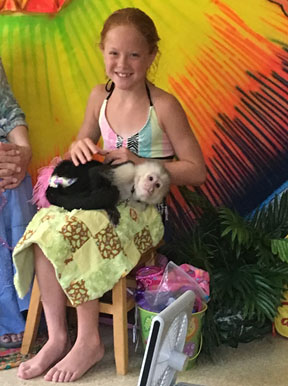
Sissy Lou-La-La
Welcome friends to the Primate Care site. This month we will be talking about the issue of training. I certainly do not call myself a trainer but there are many others who do now in the world of monkeys. It is my opinion that you must first teach and (might I add the word demand) “Monkey Manners Training” before you can begin to train your monkey to do other things such as tricks.
Many years ago, I purchased my first dog. She had been sold back to the pet shop due to the owners having to move, and they could not take her. She was a wild little thing and had not been shown any manners at all. I was so excited to have my very own little Yorkie. She and my husband hit it off first thing and he started teaching her to jump from the floor to get a piece of cheese from his mouth and I of course, demanded that she learn how to go outside to do her business and to calm down and learn how to be held.
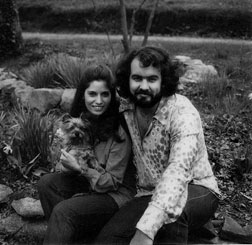
My Little Yorkie “Pandy
Learning How To Be Held For A Photo
As the years passed, those little legs became crippled from doing all of the jumping that she had done on command and she became a little dog that had chronic pancreatic problems due to the amount of fat that had been given to her while doing her tricks. These problems made it very hard for her to have a normal type of old age. So, as we all do in living life, we are constantly referring back to things that we wish that we had chosen to do differently. I believe this is probably one of the reason’s why I have chosen to focus on manners with the monkeys, rather than focus on training them to do physical things on command.
Enhancing A Natural Behavior
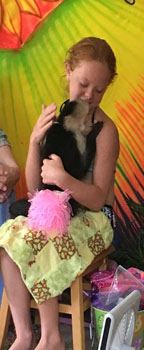
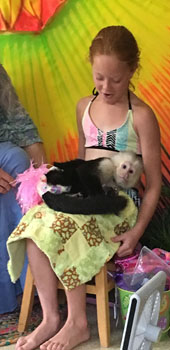
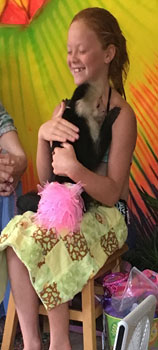
“Sissy Lou-La-La”
A Picture Is Worth A Thousand Words
In the photos above, they show Sissy Lou-La-La doing something that she naturally loves to do. I do not make her do this on command because I truly believe it is her way of choosing who she wishes to share her love with. I could have chosen to build from this special gift of hers and ask (or make) her give a hug to each and every child that visits with her during my presentations, but due to my belief in allowing people to see who my monkeys are naturally, I chose to allow her to express her true emotions and feelings freely just as the young mother and her daughter are doing in the photos.
Sissy, is an amazing monkey and truly loves to share herself with all of the guest that attend our presentations. She is my only Black and White Capuchin monkey but has made friends with another monkey who came four years ago. She is handicapped due to her foot being injured before she came to me but none of this matters to her or anyone that meets her. She knows she is special and that she is dearly loved. Even the Black-Caps love her too. When it comes to them, she may look strange but she is still a very important part of their troop and they will show anyone who might mess with their Sissy that this is true. At a time like this they all act as one unit. God bless the person or animal who might try to hurt her in front of them. This is just the way it is with a troop of monkeys.
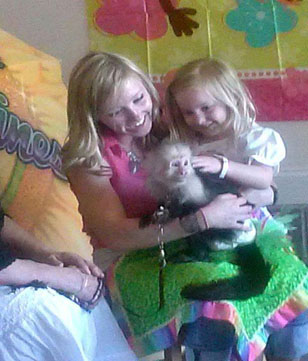
“Sissy” Enjoying Visiting With A Special Birthday Child And Her Mother
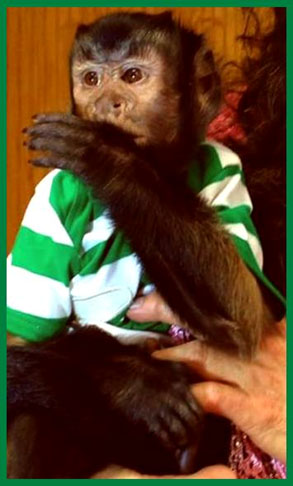
“Silly Willy” age 7
Silly Willy is a big ole’ “Thumb Sucker.” He is so cute when he does it. So, as I am opening the show with Silly Willy, I will turn and look at him and see if he is sucking his thumb. I then tell the children that he loves to suck his thumb and that if he feels comfortable with their group then he will begin to do so. Again, as with Sissy, I have chosen to not teach him to do thumb sucking on command. It is also true though, Silly Willy will not suck his thumb if he is not comfortable with a group of people.
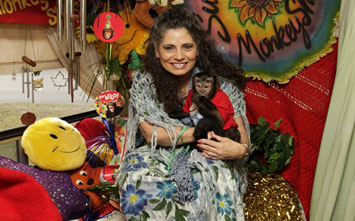
Almost All Of My Photos Of “Silly Willy”
Are With His Thumb In His Mouth
Arrival of a Re-homed Monkey
When someone is bringing us a re-homed monkey, I share my plans about their monkey with them. They also will learn that my plans will first consist of deciding which monkey or monkeys their monkey might be able to spend time with. Companionship, between monkeys is a priority for all monkeys in my troop and I always wish for the former owners to know it may take several months for most monkeys to adjust when they come.
With the other monkeys happy with the new addition to their troop, I can then begin teaching him or her their good monkey manners. It is very hard to have a monkey breaking the rules of good manners when all of the other monkeys are keeping their manners under control.
After bonding with a young monkey or a re-homed monkey, training can begin. The key to training the monkeys begins with the bonding that they get with their primary monkey caregivers and their early programming of “Monkey Manners Training.” It is important that all new monkey caregivers become aware of how early programming will effect their monkey’s behavior when they become a fully grown monkey.
Maintaining a constant behavior of “Monkey Manners” from your monkey, will make a huge difference in how they will act around your friends and family members as they grown up. You do not allow any of the rules of good manners to be broken by anyone in your world when it comes to the programming of your monkey.
With a dog, if it jumps up on a visitor at the door you may say, “Excuse me, I am so sorry about the dog doing that ill mannered thing. We are still training him.” After this statement you start cleaning their pants or skirts and tell the dog, “You are a bad dog and possibly ask your spouse to put the dog up. With a monkey it is very different. They must not be allowed to meet anyone at the door because they must always be tethered and expected to stay with you until you give permission for them to leave you or to reach for another person .
When a monkey has the combination of intelligence, proper early programming and has gained the maturity to have the ability to be a monkey who listens well, then it is very possible to train them to do many other types of things.
Before I start the list of “Basic Monkey Manners”, I do hope that you will order and read the “Living With Monkeys,” book which is listed for sale on this site. It was written as the foundation book for all things that I write here on this site, too. This book was designed to be easily read from your computer screen and will also be easy for you to refer back to often. It is a book that is extremely helpful for people who are very serious about having a monkey in their home. The “Real Truth” has been spoken in this book about the real issues of owning a monkey and you will also learn what the common mistakes are that people who obtain monkeys make. I wish to always present helpful, informed information so you have the proper facts to help you make your finial decision about obtaining a monkey.
Basic Monkey Manners
- be able to wear a diaper/(clothes etc. if you wish)
- be able to wear a neck tether or belly band with a lead
- be able to sit with me in my arms
- be able to be carried around in my arms
- be able to go in and out of a cage easily
- be able to meet and greet people without the need to attack them (from a distance)
- be able to be a good listener
- be able to come to me or remain still when I wish to find them if they are out of their enclosure running free
- be able to switch things out with them easily
- be able to teach them not to put their mouth on anyone’s hands and other body parts
- be able to be carried around in a sling in the front of my body
- be able to have their nails cared for and to get a bath
WARNING: Please, never leave a neck tether or body band with a long lead on your monkey while they are running free in your home or in their enclosure. Put a sign on their enclosure for other people that might remove your monkey from their enclosure so that they do not ignore this important “Safety-First” rule. Many monkeys have lost their life from this type of accident happening. Wrap your monkey in love and good “Safety-First” rules instead of fear and worry.
The above list is the first things that I start working on with my monkeys when they first come to us. I do this because I know these manners will benefit them as they are living their lives in captivity. It can take many hours of (one-on-one) time to teach the things on this above list.
After spending this precious, important time, with your monkey as you are teaching them these types of mannerly things, you will see that the rewards will be well worth doing it. The time you spend working with a monkey on manners will also bring you to a place of peace. When you establish these manners with your monkey, and always require them to use them (at all times), then you can begin teaching them other things as they grow and change through life.
Why Do I Need To Carry My Monkey In My Arm: Many monkey caregivers feel that they are safely carrying their monkey with them when they have their monkey on their shoulders. This is easy training because a monkey loves to go to the highest place at any given time. However, a monkey will be closer to your heart when you carry it in your arms. They need to be comfortable in front of your body. I have chosen to hold their tail also when they are being carried. This is also a safer place for them in case someone in your family comes up behind you much to quickly.
Monkeys do not like fast movements and they especially do not like movements coming towards them when they are not expecting it. This very thing happening can cause an unexpected fear response from your monkey. It is okay for them to move quickly, but it is not okay for them to have us doing the same thing. We as monkey caregivers understand very soon after obtaining a monkey that we must understand them and that we are their humans for sure.
Rewards From Teaching “Monkey Manners”
- you will give them the gift of bonding with you and your bonding with them
- you will have the protection of a diaper being there when you are working with your monkey
- you will establish the role of alpha with your monkey
- you will have established good rules of being a great “Safety First” type of monkey caregiver – which has been written about here on this site (these post are listed under the archives)
- you will have peace of mind when people unexpectedly arrive at your home and you have the monkey out of it’s enclosure
- you will be able to quickly locate your monkey when you must allow the door to be opened or you are about to leave your home
- you will make time to spend with your monkey while teaching them these important mannerly behaviors
- you will be teaching your monkey positive things instead of playing with your monkey (which is one of the things on the list of mistakes people make when raising a monkey)
- Did I say “Peace Of Mind?“ This is the most important gift that you will receive from training your monkey to have these manners.
Please remember: It is very hard to have a monkey living with you who does not wear a diaper. It is great to have them wear clothes due to warmth issues but not a necessity. But, wearing a diaper is one of the things which will allow you to have more quality time with them. Please take the time and effort to train your monkey how to have this very important mannerly tool. Teach them and yourself and other caregivers to be able to diaper your monkey. This issue will keep you enjoying your monkey for it’s entire lifetime. Ugh – not everyone can diaper my monks. I am trying to work on this issue all of the time but my monkeys do not live in diapers. They are only diapered when they are out of their enclosures, and I do not mind the monkey clean up. With my monkeys not wearing diapers in their enclosures I do not have diaper rash problems.
Now, Let’s Talk About Some Of The Different Methods Of Training Your Monkey To Do Other Types Of Things. There are now many monkey trainers and training methods that you can begin learning about, if you wish to teach your monkey other things. These are typical “dog training techniques.”
Training Procedures
- most all animal or (monkey trainers) will use basic dog-training procedures which include things like:
- with-holding food and getting them hungry before you begin their training session and then using treats to feed them when they do things you want them to do properly
- small electric shock when they do not do things properly
- making them repeat the task repeatedly – without a form of praise or a treat when they do not preform the tasks properly
- feeding them a treat when they do things properly
- using a clicker to train with is also another type of training that can be used with dogs and monkeys
Important Statement: Many monkeys can be amazingly smart and can be taught to do all different types of things. I know that dog training techniques have become acceptable ways of training monkeys. There is a large number of people who seem to really enjoy training their monkeys and will continue to teach them many incredible types of things as time goes on.
As I have been watching many of the things that monkeys have been trained to do, the one thing that I see missing in many of these monkeys is the sparkle of joy in their eyes, heart, and energy when they are doing their tricks. This cannot be trained into an animal, especially a monkey. You can show them certain things though that they just love to do and then this is when pure joy happens for the trainer and the monkey. This is the way I have always hoped for my monkeys training to be. I have such a loving relationship with them that I will not push to teach them something that they do not love to do. To me it is not worth the time and trouble to teach them something that they do not absolutely love.
Animals Can Teach Us Their Special Medicines
When the American Indian tribes (and other countries tribes) were living off of the land, a big part of their education was presented from their elders who would pass on the teaching from each animal they came in contact with. These animal teachings are called their “Medicine.”
The teaching of the “Dog Medicine” is that of “Loyalty.” They are naturally this type of animal and display this in their behaviors all of the time. They are very forgiving and will come back to you even after your treatment of them has been harsh. They are such wonderful teachers of “Loyalty.” The medicine of the animals could be looked at in (a positive way or a negative way) depending upon what your encounter with a dog could be trying to show you from your experience with them. If you are a person that has trouble with being loyal then you will understand why the teaching of the dog medicine is important to you. However, if you are a person that has strong values in being loyal you will understand why the encounter with dog medicine was happening the way that it did. We humans need this lesson repeatedly shown to us by our precious, loyal, four legged creatures.
Now, to learn about The Medicine of The Monkey: the teaching of the “Monkey Medicine” is that of “Family Issues”. If you spend some time thinking about this you will realize that this is also very true. A monkey’s ability to remember their unfair treatments or choosing to carry a grudge or judgment against a thing they did not like or a person that that they did not like, is awesome and so human like.
Monkeys never seem to forget what they have learned and will often remind us of people that act just like them. Their grudges can last for years and sometimes may remain part of their personalities and their natural behaviors for their entire lives. Monkeys are particularly wonderful at teaching us about divided loyalties and playing one person against another which are all typical lessons of “Family Issues”. The positive aspect of the monkeys medicine is when they will drop their judgments and old emotional feelings and choose to embrace people and things in a new way.
Due to monkeys never forgetting things that they learn, it is best for all concerned that the less monkey mistakes we make the better life will be with them. Does this sound like familiar human thinking? ‘Yes,’ it does. We must also think about how the monkey teachers of “Family Issues,” can swing in a wonderful direction, like always remembering that they love seeing us come in the door. There are so many wonderful things monkeys can teach us humans as they reflect back to us many of the same behaviors that we as humans have.
So, with these two different animal’s natural God-given behaviors, we clearly learn that dogs and monkeys are not anything alike when it comes to their emotional responses. I hope learning about just two of the animal medicine teachings is awesome to you My favorite animal medicine teacher has always been Jamie Sams. Through her books and tapes she has taught me how to understand the deepest ways that animals have come to help us become better humans.
Monkeys have such a wonderful loving nature and seems to truly wish to please us
Being able to be consistent with a monkey and show them unconditional love, kindness, understanding and acceptance, will always be the most positive things to remember when training a monkey. When a monkey feels loved they wish to please us. We must not forget these positive actions that we must show them in dealing with their behaviors and feelings.
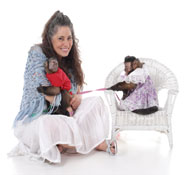

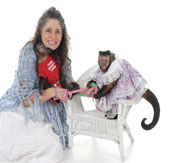
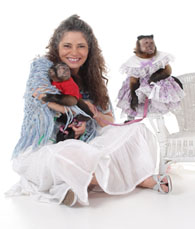
“Silly Willy” and “Maggie Mae
Maggie Mae Is The Alpha Monkey Of The Troop-She Has Received Many “Big Looks”
We must also never forget to be able to teach them that we are the alpha of the (troop or group we live with) and that we are ready and able to allow our monkey to show us (thru good manners and behaviors) who they are and the things they like to do. Learning about them and their likes and dis-likes is awesome, and I am honored to be able to teach others how to have a happy, well adjusted monkey living in your home.
Our Precious Monkeys Will Learn Behaviors From The Other Members Of Your Family That You Live With
We must also remember that we who live with family around us, are living with other humans who have different likes and dislikes and good and bad behaviors. So, they will pick up the energy of the fights they will see and react to verbal abuse or physical violence, too. They are like having another child in your home, and like a child, they see and hear everything as our behaviors are constantly being programmed into them.
Therefore, when you are thinking about adding a monkey into your life there are many things that need to be thought about and at the same time, please remember to realize that we never have guarantees in living life with or without a monkey in our lives. Becoming a healthy thinking person and living with other healthy thinking family members is a must-have in order to raise a mannerly trained monkey. This is not just an animal that you have complete control over. Your family members must understand and stand by the limits and programming that you wish to show to your monkey.
*******************************************************
Please do not obtain a monkey if you are are not living in a happy loving home. It will not work out in a positive way for any of your loved ones, the hairy ones or the non-hairy ones.
*******************************************************
The important training starts first with the basics “Monkey Manners Training:” When you are able to get these things instilled within your monkey’s behavior, your other training (no matter what that may turn out to be) will be easier to do because of their grounding in their “Monkey Manners Training.”
When a monkey finds something that they love wholeheartedly to do, this turns out to be what is truly amazing to see. The pure joy of doing this special thing is pouring out of them. You do not need to change your voice in order to make them know that you want them to do it on command. They know the joy of being able to do what they love to do and will be happy doing it!
Is this trained? Yes, probably (in a small way or maybe in a huge way) it is trained because you showed him or her by doing it in front of them. This is the same way children are constantly learning. They learn what they see others do. The phrase “Monkey See, Monkey Do,” is a true statement when it comes to small children and monkeys.
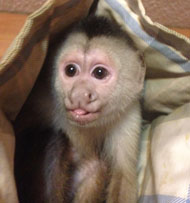
“Casper” Is Such A Character
I love it when I go over to visit with Casper. I have written about him and his parents, Danny and Lisa Covington often, here on the Primate Care site. When Lisa and I are out “thrift storing” we are constantly looking for different types of balls. We do this because many of our monkeys love to play with balls. But, when I go over to see Casper, (of course, he and I are always both happy to see each other) I love to see him playing with his colorful balls. He throws them up and down, he eats food on them, he stands and jumps on them, he even will sleep with his ball pressed up against his back while he is covered up with his blanket. He loves them so much. He is truly in a state of pure bliss when he has a special ball that he is playing with.
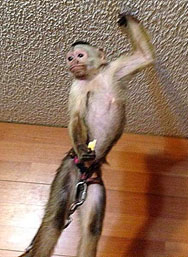
“Casper” In His Favorite Flinging Place
Is This “Ball Thing” A Trick For Casper? I would have to say ‘yes’ very much so. He is in a state of pure bliss, when he has a special ball that he is playing with. So, I must go back on what I have just said and now say; ‘no,’ this is not a trained trick but it is a “pure joy trick” and he has expanded on this in his own perfect way. This is now part of who Casper is. This has become apart of his unique personality and ability to love doing something and showing off his true talents!
Many People Love To Do Training With Their Dogs, Monkeys Horses And Other Types Of Animals. I love to teach my monkeys “good manners” and give them the abilities to be comfortable and happy in being monkeys who live in captivity. They are excited to spend time with me and many other people who visit us here at our crazy house. To the best of my knowledge, the monkeys who go with me are excited to go and they enjoy their time away from the other members of their monkey troop. They are being enriched by having time in the van, seeing new things and having time with different people.
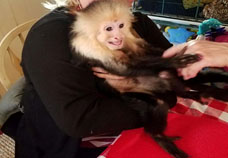
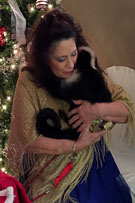
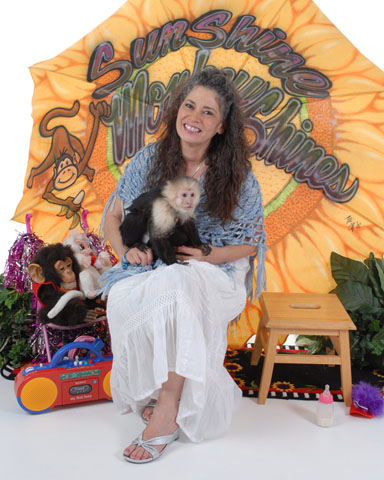
Sissy Lou-La-La
When we go out to do our presentations, Sissy and Silly Willy seem to love being close enough so they can start fussing at each other. I cannot figure out why the black-caped Capuchin monkeys do not like to be with the black and white Capuchin monkeys, at least in my troop, this is the way it seems to be. Ugh… but I must call it enrichment I guess. It seems that everything when you have a monkey living with you, must be enrichment. Monkeys who live in captivity are in service to us so I wish for all of these monkeys to have great lives. This site and all of my writing is dedicated to helping people make better decisions about becoming monkey caregivers and to help people understand that the monkeys are constantly helping us all to become better humans.
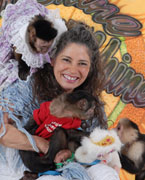
The Black-Caps Fussing At “Sissy”
Silly Willy, seems to know how much I love Sissy, and it appears to be a clear cut case that they are jealous of each other. But, as far as any experienced monkey caregiver will tell you, monkeys can show one or more of the “basement types of emotions” much to often. They can especially show their issue with jealousy from the list of “basement emotions.” Oh yes, they will let you know very quickly that they are being jealous of a certain person, place or even possessive of a thing. They want what is theirs and what is yours too!
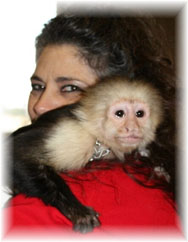
Sissy Lou-La-La Learning To Be On My Shoulder
Remember when training your “Monkey Manners”, to use the same words, phrase and hand signal, with them when you are asking them to go up to your shoulder or into their enclosure. I will say to Sissy, “Sissy, up. Then I will say “shoulder” as I am tapping my shoulder. If I were to switch the words or hand signals she might be very confused and possibly not do what is asked of her.
Once a command is issued please remember to follow through with the command until they respond. I never say, “Oh, you do not have to do that.” A command is a command and they always need to know that you will not stop or change the command.
I have not had children but I have had many monkeys for a very long time and they are my family. Because I have never had children I may look at the monkey training in a different way. I love to see a monkey choose to be good all on its own. To me this will always be the very best type of training. I have always wanted my monkeys to grow up and make good choices as they get older. So, far this is happening with my Silly Willy, who is the star of the book, “Living With Monkeys.” He no longer needs to miss-behave when he is out of his enclosure; that would take away the fun of being with us. He teaches us the positive side of being a “Monkey Medicine Teacher,” and that is “choosing to enjoy his life with us.” My husband and I have always chosen to be consistent with him as we were teaching him his “Early Programming and Monkey Manners.” This is an important key to being successful as we are living with monkeys.
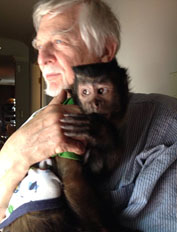
“Silly Willy” With His Daddy
Choose to be the very best Monkey Caregiver that you can be.
Thank you for visiting us here at Primate Care. We are committed to bringing good information for you to think about and share with your family, friends, and other monkey caregivers. In the next posting on the Primate Care site we will be talking about Monkey tethers and leads.
Written by Mary Lynn Campbell author of “Living With Monkeys”
